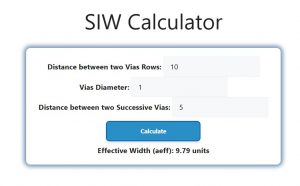About SIW Calculator (Formula)
The Substrate Integrated Waveguide (SIW) Calculator is used in electronics and telecommunications to evaluate the effective width of an SIW structure. SIW technology is widely applied in high-frequency communication systems as it helps design compact, efficient, and cost-effective waveguides. This calculator aids engineers and researchers in optimizing SIW structures by calculating the effective width (aeff) based on physical parameters, making it an essential tool in the field of microwave engineering.
Formula
The formula for calculating the effective width (aeff) of a substrate integrated waveguide is:
Effective Width (aeff) = Actual Width (a) − (Diameter of Via Holes (d)² / (0.95 * Spacing of Vias (s)))
Where:
- a is the actual width of the waveguide.
- d is the diameter of the via holes in the SIW.
- s is the spacing between the vias.
How to Use
- Determine the Actual Width (a): Measure the actual width of the waveguide.
- Find the Diameter of Via Holes (d): Measure the diameter of the vias used in the SIW structure.
- Calculate the Spacing (s): Measure the spacing between the vias.
- Input Values: Enter the values for a, d, and s into the SIW Calculator.
- Calculate Effective Width (aeff): The calculator will provide the effective width based on the given values.
Example
Example: Suppose we have a waveguide with an actual width (a) of 10 mm, via hole diameter (d) of 1 mm, and spacing between vias (s) of 5 mm. To find the effective width:
Effective Width (aeff) = 10 − (1² / (0.95 * 5))
Effective Width (aeff) = 10 − (1 / 4.75)
Effective Width (aeff) ≈ 9.79 mm
So, the effective width of the SIW structure would be approximately 9.79 mm.

FAQs
- What does SIW stand for?
SIW stands for Substrate Integrated Waveguide, a technology used in microwave circuits for efficient signal transmission. - How does the SIW Calculator help?
It calculates the effective width of an SIW, which is crucial for designing compact and efficient microwave circuits. - What is effective width (aeff) in SIW?
Effective width is the modified width of the SIW that accounts for the effects of vias, enhancing waveguide performance. - Why is effective width important in SIW design?
Effective width impacts the waveguide’s performance, ensuring optimal signal transmission and frequency control. - How do via holes affect SIW performance?
Via holes influence the electromagnetic field within the waveguide, impacting the effective width and overall performance. - What units should be used in the formula?
It is best to use consistent units, such as millimeters (mm), for width, diameter, and spacing. - Why do we divide by 0.95 in the formula?
The factor 0.95 adjusts for the effect of via spacing in the substrate, refining the effective width calculation. - Is the SIW Calculator only useful for certain frequencies?
SIW is commonly used for high-frequency applications, but effective width calculations are relevant across frequency ranges. - What applications use SIW technology?
SIW technology is used in antennas, filters, and other microwave devices for telecommunications and radar. - Can I use the calculator for different substrate materials?
Yes, but effective width will also depend on the dielectric properties of the substrate material. - What happens if via spacing (s) is too large?
Large spacing may decrease wave confinement and reduce efficiency, impacting waveguide performance. - What is the optimal range for via diameter (d)?
The via diameter should balance confinement with space constraints; smaller diameters generally improve waveguide performance. - Does temperature affect SIW calculations?
Temperature can influence substrate properties, but it typically has a minor effect on SIW calculations for many applications. - Why is SIW preferred over traditional waveguides?
SIW offers a compact, planar design that integrates well with PCB technology, reducing cost and complexity. - How accurate is the SIW Calculator?
The calculator provides reliable approximations, but real-world testing may be needed for precise tuning. - Can SIW be used in 5G networks?
Yes, SIW technology is suitable for 5G networks, offering efficient and compact design for high-frequency applications. - What is the difference between actual width and effective width?
Actual width is the physical width of the waveguide, while effective width accounts for the influence of via holes. - Is SIW used in wearable technology?
Yes, due to its compact size and compatibility with PCB technology, SIW is used in wearable communication devices. - How can effective width adjustments improve signal quality?
Proper adjustments enhance signal confinement and reduce losses, improving overall signal quality in SIW structures. - Is an SIW Calculator useful for beginners in RF design?
Absolutely, it simplifies calculations, making it a great tool for those new to microwave and RF design.
Conclusion
The SIW Calculator is an essential tool in microwave and telecommunications engineering, simplifying the process of determining the effective width of a substrate integrated waveguide. By considering the impact of via holes and spacing, the calculator provides an accurate estimate of a critical parameter for efficient waveguide design. With the SIW Calculator, engineers and designers can quickly assess and optimize waveguide performance, making it a valuable addition to any RF and microwave design toolkit.